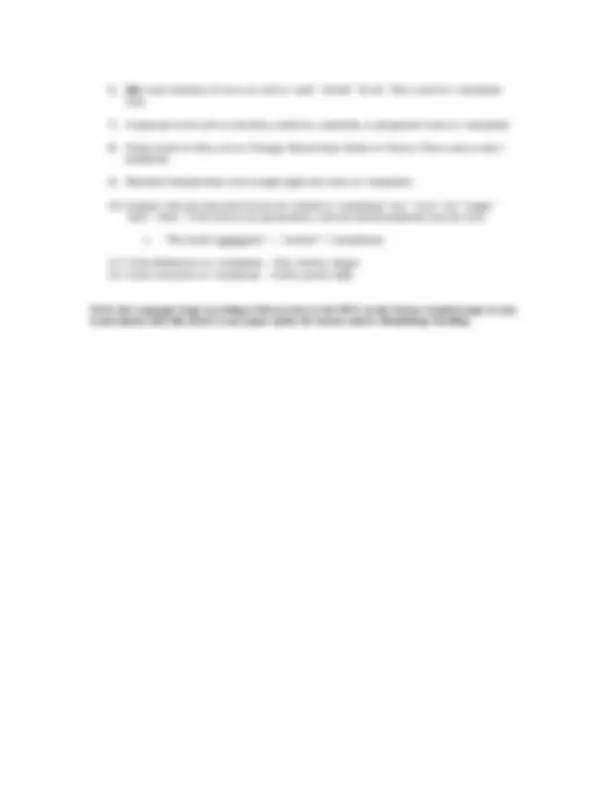



Study with the several resources on Docsity

Earn points by helping other students or get them with a premium plan


Prepare for your exams
Study with the several resources on Docsity

Earn points to download
Earn points by helping other students or get them with a premium plan
Community
Ask the community for help and clear up your study doubts
Discover the best universities in your country according to Docsity users
Free resources
Download our free guides on studying techniques, anxiety management strategies, and thesis advice from Docsity tutors
Material Type: Project; Professor: Smith; Class: Normal Sp/Lang Acquisition; Subject: Communication Disorders; University: Central Michigan University; Term: Fall 2009;
Typology: Study Guides, Projects, Research
1 / 2

This page cannot be seen from the preview
Don't miss anything!


CDO 130-Fall 2009 SLS Morpheme Count Instructions You will be examining the language growth of a child based on their use of morphemes. Remember that a morpheme is the smallest unit of meaning in a language. There are 2 types of morphemes – both free and bound. Free morphemes can stand alone and have meaning whereas bound morphemes have no meaning on their own. They must be attached to a free morpheme to make sense. Roger Brown was the individual who provided us with the ability to measure how children acquire speech and language. His research, more commonly known as “Brown’s Stages” describes the syntactical or structural development that children go through when acquiring speech and language. Brown traced the development of syntax through 5 major stages. He was able to track this development by measuring the mean length of utterance (MLU) in any given language sample of a child. So what is MLU? When we have a sample of a child’s language, there may be some utterances that have only single free morphemes (i.e. if a child says “No”) or some utterances that may contain four or five morphemes (i.e. “I want to go outside”). Some utterances may contain only free morphemes while others may have both free and bound morphemes. To calculate the mean (or average) length of a child’s utterance we count the morphemes in each utterance, add the total , and divide by the total number of utterances. EXAMPLE: Out of 50 utterances a child’s total morpheme count is 200 To figure out MLU take 200 and divide by 50 Total MLU = 4. What does all this mean? Well, one would expect that as a child gets older and learns more and more about language, then their MLU or mean length of each sentence they speak would also get longer to reflect their language growth. This is in fact what Roger Brown discovered. His research summarizes the five stages children go through as they develop language, with each stage showing in increase in both age and MLU. One goal for you to accomplish with this project is to determine what the child’s MLU is and what Brown’s Stage corresponds to their sample. Remember that the Brown’s Stage that is assigned to each child is based on MLU only and not their age! RULES FOR COUNTING MORPHEMES AND COMPUTING MLU 1) Count the number of morphemes and total them for 50 utterances spoken by the child. Put the number for each utterance in the column provided on your transcription. 2) Divide this total by the number of utterances (50) to get MLU. 3) Count both free and bound morphemes. Frequent bound morphemes include but are not limited to: a. Plural –s b. Possessive –‘s c. Past tense –ed d. 3 rd^ person present tense –s e. Progressive –ing 4) Contractions such as “don’t” and “can’t” counts as 2 morphemes. 5) Count only the morphemes that are outside parentheses. DO NOT count as morphemes such “fillers” as ‘um’ ‘uh’. Omit false starts and repetitions, which have been enclosed in parentheses, from the morpheme count.
6) DO count variations of yes or no such as ‘yeah’ ‘uh huh’ ‘uh uh’. They count for 1 morpheme each. 7) Compound words such as lunchbox, sunflower, somebody, or playground count as 1 morpheme. 8) Proper names or titles, such as Teenage Mutant Ninja Turtles or Trick-or-Treat count as only 1 morpheme. 9) Ritualized reduplications such as night-night also count as 1 morpheme. 10) Irregular verb and noun plural forms are counted as 1 morpheme ‘saw’ ‘went’ ‘ran’ ‘taught’ ‘mice’ ‘teeth’. If the form is over-generalized, count the bound morpheme and root word. a. “My teacher teached me” --- ‘teached’ = 2 morphemes 11) Count diminutives as 1 morpheme – kitty, mommy, doggie 12) Count catenatives as 1 morpheme – wanna, gonna, hafta Write the Language Stage according to Brown next to the MLU on the Syntax Analysis page of your transcription and talk about it your paper under the Syntax and/or Morphology heading.